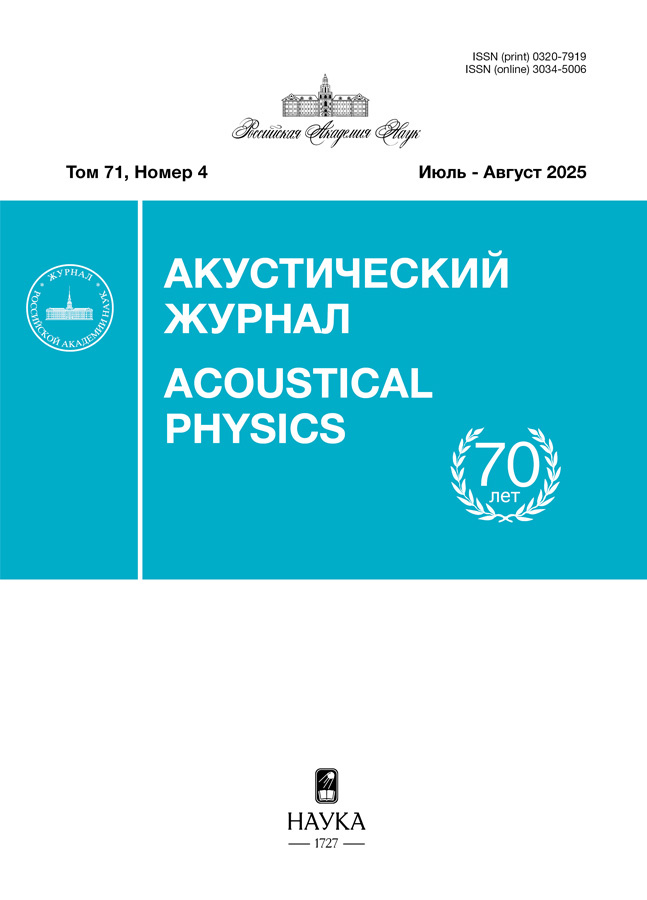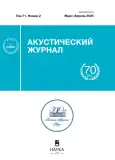Флуктуации акустического импульсного отклика и когерентная звукоподводная связь в мелком море в осенних условиях
- Авторы: Шатравин А.В.1,2
-
Учреждения:
- Институт Океанологии им. П.П. Ширшова РАН
- Институт общей физики им. А.М. Прохорова РАН
- Выпуск: Том 71, № 2 (2025)
- Страницы: 241-259
- Раздел: АКУСТИКА ОКЕАНА. ГИДРОАКУСТИКА
- URL: https://bakhtiniada.ru/0320-7919/article/view/306621
- DOI: https://doi.org/10.31857/S0320791925020082
- EDN: https://elibrary.ru/ijcaai
- ID: 306621
Цитировать
Аннотация
Ключевые слова
Об авторах
А. В. Шатравин
Институт Океанологии им. П.П. Ширшова РАН; Институт общей физики им. А.М. Прохорова РАН
Email: ashatravin@ocean.ru
Нахимовский проспект 36, Москва, 117997 Россия; ул. Вавилова 38, Москва, 119991 Россия
Список литературы
- Rudnick D. L. Ocean research enabled by underwater gliders // Annual review of marine science. 2016. V. 8. P. 519–541.
- Островский А.Г. и др.Автономный мобильный аппаратно-программный комплекс вертикального зондирования морской среды на заякоренной буйковой станции // Океанология. 2013. Т. 53. № 2. С. 259–259.
- Krishfield R. et al.Automated ice-tethered profilers for seawater observations under pack ice in all seasons // J. Atmospheric and Oceanic Technology. 2008. V. 25. № 11. P. 2091–2105.
- Roemmich D., Owens W.The Argo project: Global ocean observations for understanding and prediction of climate variability // Oceanography. 2000. V. 13. № 2. P. 45–50.
- Ostrovskii A.G. et al.Automated tethered profiler for hydrophysical and bio-optical measurements in the Black Sea carbon observational site // J. Marine Science and Engineering. 2022. V. 10. № 3. P. 322.
- Бреховских Л.М., Лысанов Ю.П.Теоретические основы акустики океана. Л.:Гидрометеоиздат, 1982.
- Fisher F.H., Simmons V.P.Sound absorption in sea water // J. Acoust. Soc. Am. 1977. V. 62. № 3. P. 558–564.
- Sozer E.M., Stojanovic M., Proakis J.G.Underwater acoustic networks // IEEE J. Oceanic Engineering. 2000. V. 25. № 1. P. 72–83.
- Chitre M., Shahabudeen S., Stojanovic M.Underwater acoustic communications and networking: Recent advances and future challenges // Marine Technology Soc. J. 2008. V. 42. № 1. P. 103–116.
- González-García J. et al.Autonomous underwater vehicles: Localization, navigation, and communication for collaborative missions // Applied sciences. 2020. V. 10. № 4. P. 1256.
- Ali M.F. et al.Recent advances and future directions on underwater wireless communications // Archives of Computational Methods in Engineering. 2020. V. 27. P. 1379–1412.
- Zia M.Y. I., Poncela J., Otero P.State-of-the-art underwater acoustic communication modems: Classifications, analyses and design challenges // Wireless personal communications. 2021. V. 116. P. 1325–1360.
- Sendra S., Lloret J., Jimenez J.M. and Parra L.Underwater acoustic modems // IEEE Sensors J. 2015. V. 16. № 11. P.4063–4071.
- Акуличев В.А.,Каменев С.И., Моргунов Ю.Н.Применение сложных акустических сигналов в системах связи и управления подводными объектами // Докл. Акад. наук. 2009. Т. 426. № 6. С. 821–823.
- Моргунов Ю.Н., Буренин А.В., Безответных В.В., Голов А.А.Распространение импульсных псевдослучайных сигналов из шельфа в глубокое море в зимних гидрологических условиях Японского моря // Акуст. журн. 2017. Т. 63. № 6. С. 646–650.
- Моргунов Ю.Н., Безответных В.В., Голов А.А., Буренин А.В., Лебедев М.С., Петров П.С. Экспериментальное исследование импульсной характеристики волновода Японского моря с использованием псевдослучайных последовательностей в приложении к навигации удаленных объектов // Акуст. журн. 2021. Т. 67. № 3. С.291–297.
- Song H.C. et al.Long-range acoustic communication in deep water using a towed array // J. Acoust. Soc. Am. 2011. V. 129. №3.P. EL71–EL75.
- Shimura T. et al.Long-range time reversal communication in deep water: Experimental results // J. Acoust. Soc. Am. 2012. V. 132. № 1. P. EL49–EL53.
- Freitag L., Stojanovic M.Basin-scale acoustic communication: A feasibility study using tomography m-sequences // MTS/IEEE Oceans 2001. An Ocean Odyssey. Conference Proc. (IEEE Cat. No. 01CH37295). IEEE, 2001. V. 4. P. 2256–2261.
- Sklar B.Digital Communications. NJ, Englewood Cliffs: Prentice-Hall, 2001.
- Proakis J.Digital Communications. NY USA: McGraw-Hill, 2001.
- Jeruchim M.C., Balaban P., Shanmugan K.S.Simulation of communication systems: modeling, methodology and techniques. Springer Science & Business Media, 2006.
- Stojanovic M.Underwater acoustic communications: Design considerations on the physical layer // 2008 Fifth Annual Conf. on Wireless on Demand Network Systems and Services, 2008 Jan 23. P. 1–10. IEEE, 2008.
- Kilfoyle D.B. and Baggeroer A.B.The state of the art in underwater acoustic telemetry // IEEE J. Oceanic Engineering. 2000. V. 25. № 1. P. 4–27.
- Stojanovic M. and Preisig J.Underwater acoustic communication channels: Propagation models and statistical characterization // IEEE Communications Magazine. 2009. V. 47. № 1. P. 84–89.
- Yang T.C.Properties of underwater acoustic communication channels in shallow water // J. Acoust. Soc.Am. 2012.V. 131. №1.P.129–145.
- Бобровский И.В., Яготинец В.П.Экспериментальные исследования акустической системы связи в условиях мелководья // Акуст. журн. 2013. Т. 59. № 6. С.667–667.
- Курьянов Б.Ф., Пенкин М.М.Цифровая акустическая связь в мелком море для океанологических применений // Акуст. журн. 2010. Т. 56. № 2. С. 245–255.
- Rodionov A.Y., Kulik S.Y. and Unru P.P.Some trial results of the hydro acoustical communication system operation for AUV and ASV group control and navigation // In OCEANS 2016, September. MTS/IEEE Monterey. P. 1–8. IEEE, 2016.
- Qarabaqi P. and Stojanovic M.Statistical characterization and computationally efficient modeling of a class of underwater acoustic communication channels // IEEE J. Oceanic Engineering. 2013. V. 38. № 4. P. 701–717.
- Preisig J.C.Performance analysis of adaptive equalization for coherent acoustic communications in the time-varying ocean environment // J. Acoust. Soc. Am. 2005. V. 118. № 1. P. 263–278.
- Chitre M.A high-frequency warm shallow water acoustic communications channel model and measurements // J. Acoust. Soc. Am. 2007. V. 122. № 5. P. 2580–2586.
- Siderius M., Porter M.B., Hursky P., McDonald V. and KauaiEx Group.Effects of ocean thermocline variability on noncoherent underwater acoustic communications // J. Acoust. Soc. Am. 2007. V. 121. № 4. P. 1895–1908.
- Qarabaqi P. and Stojanovic M.Modeling the large scale transmission loss in underwater acoustic channels // In49th Annual Allerton Conf. on Communication, Control, and Computing (Allerton), 2011, September. P. 445–452. IEEE, 2011.
- Song A., Badiey M., Newhall A.E., Lynch J.F., DeFerrari H.A. and Katsnelson B.G.Passive time reversal acoustic communications through shallow-water internal waves // IEEE J. Oceanic Engineering. 2010. V. 35. № 4. P. 756–765.
- Yang T.C.The effect of internal waves on low-frequency underwater acoustic communications // J. Acoust. Soc. Am. 2004. V. 115. № 5. P. 2469–2469.
- Carbone N.M. and Hodgkiss W.S.Effects of tidally driven temperature fluctuations on shallow-water acoustic communications at 18 kHz // IEEE J. Oceanic Engineering. 2000. V. 25. № 1. P. 84–94.
- Song A., Badiey M., Song H.C., Hodgkiss W.S., Porter M.B. and the KauaiEx Group.Impact of ocean variability on coherent underwater acoustic communications during the Kauai experiment (KauaiEx) // J. Acoust. Soc. Am. 2008. V. 123. № 2. P. 856–865.
- Preisig J.Acoustic propagation considerations for underwater acoustic communications network development // ACM SIGMOBILE Mobile Computing and Communications Review. 2007. V. 11. № 4. P. 2–10.
- van Walree P.A. et al.The watermark benchmark for underwater acoustic modulation schemes // IEEE J. Oceanic Engineering. 2017. V. 42. № 4. P. 1007–1018.
- Зацепин А.Г., Островский А.Г., Кременецкий В.В. и др.Подспутниковый полигон для изучения гидрофизических процессов в шельфово-склоновой зоне Черного моря // Изв. Рос. Акад.наук.Физикаатмосферыиокеана. 2014.Т. 50. № 1.С. 16.
- Rife D.D., Vanderkooy J.Transfer-function measurement with maximum-length sequences // J. Audio Engineering Society. 1989. V. 37. № 6. P. 419–444.
- Stojanovic M., Proakis J.G., Catipovic J.A.Performance of high-rate adaptive equalization on a shallow water acoustic channel // J. Acoust. Soc. Am. 1996. V. 100. № 4. P. 2213–2219.
- Del Grosso V.A.New equation for the speed of sound in natural waters (with comparisons to other equations) // J. Acoust. Soc. Am. 1974. V. 56. № 4. P. 1084–1091.
- Porter M.B.The bellhop manual and user’s guide: Preliminary draft // Heat, Light, and Sound Research, Inc., La Jolla, CA, USA, Tech. Rep. 2011. V. 260.
- Katsnelson B., Petnikov V. and Lynch J.Fundamentals of shallow water acoustics. V.1. New York: Springer,2012.
- Волков М.В., Григорьев В.А., Жилин И.В., Луньков А.А., Петников В.Г., Шатравин А.В.Мелководный акустический волновод арктического типа как канал для передачи информации при звукоподводной связи // Акуст. журн. 2018. Т. 64. № 6. С. 676–681.
- Hamilton E.L.Compressional-wave attenuation in marine sediments // Geophysics. 1972. V. 37. №4. P. 620–646.
- Akal T.The relationship between the physical properties of underwater sediments that affect bottom reflection // Marine Geology. 1972. V.13. №4. P. 251–266.
- Григорьев В.А., Кучер К.М., Луньков А.А., Макаров М.М., Петников В.Г.Акустические характеристики дна озера Байкал // Акуст. журн.2020.Т. 66. № 5.С. 517–526.
Дополнительные файлы










